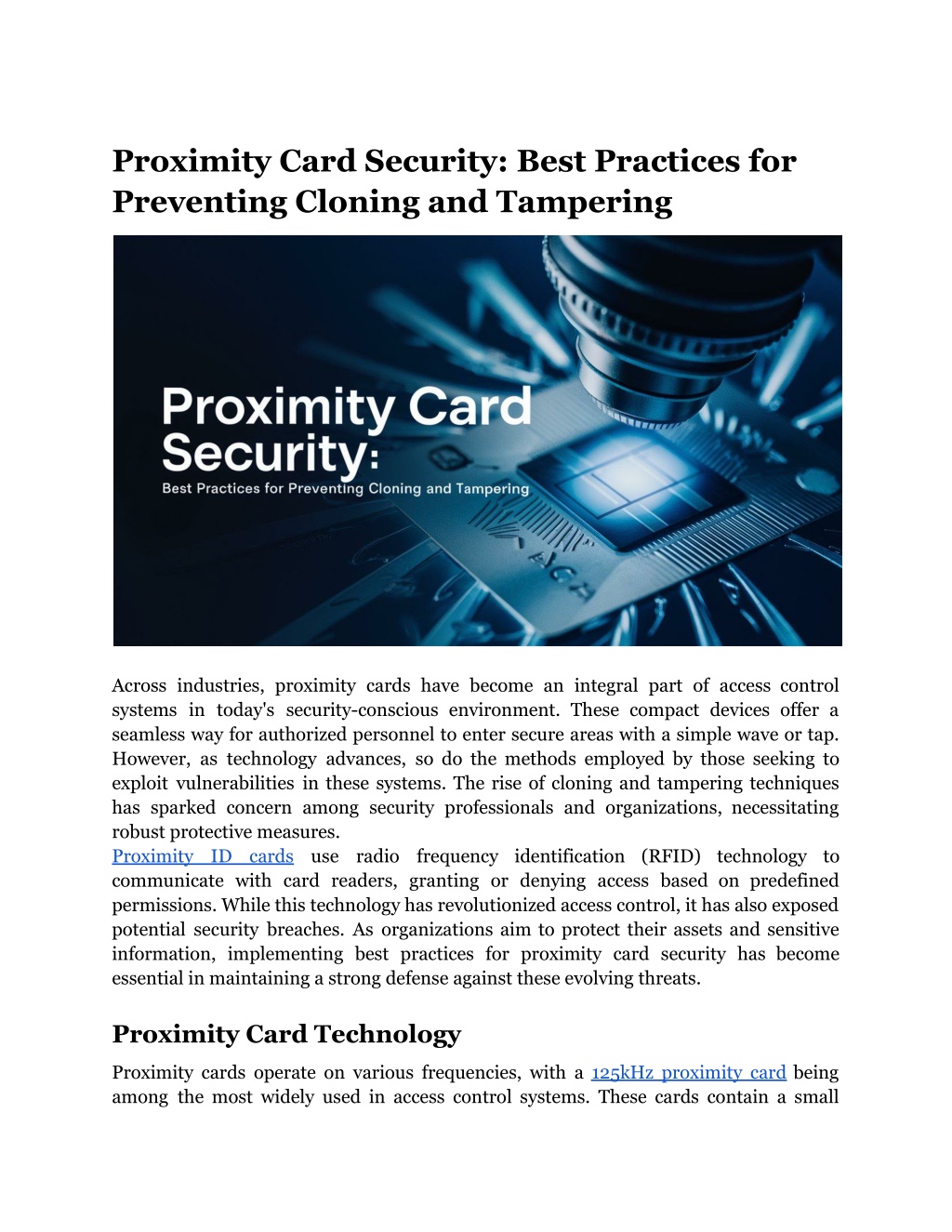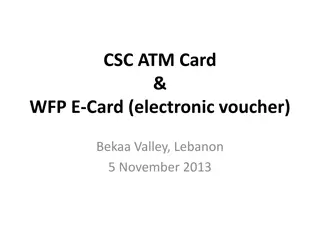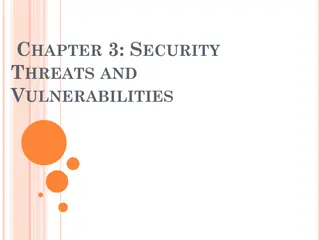
Proximity Card Security_ Best Practices for Preventing Cloning and Tampering
Discover effective strategies to prevent cloning and tampering of proximity cards, ensuring your security remains intact.
Download Presentation

Please find below an Image/Link to download the presentation.
The content on the website is provided AS IS for your information and personal use only. It may not be sold, licensed, or shared on other websites without obtaining consent from the author. Download presentation by click this link. If you encounter any issues during the download, it is possible that the publisher has removed the file from their server.
E N D
Presentation Transcript
Proximity Card Security: Best Practices for Preventing Cloning and Tampering Across industries, proximity cards have become an integral part of access control systems in today's security-conscious environment. These compact devices offer a seamless way for authorized personnel to enter secure areas with a simple wave or tap. However, as technology advances, so do the methods employed by those seeking to exploit vulnerabilities in these systems. The rise of cloning and tampering techniques has sparked concern among security professionals and organizations, necessitating robust protective measures. Proximity ID cards use radio frequency identification (RFID) technology to communicate with card readers, granting or denying access based on predefined permissions. While this technology has revolutionized access control, it has also exposed potential security breaches. As organizations aim to protect their assets and sensitive information, implementing best practices for proximity card security has become essential in maintaining a strong defense against these evolving threats. Proximity Card Technology Proximity cards operate on various frequencies, with a 125kHz proximity card being among the most widely used in access control systems. These cards contain a small
antenna and microchip storing unique identification data. When brought near a compatible reader, the card transmits its information wirelessly, enabling swift and convenient authentication. ISO PVC proximity card is produced according to international standards, ensuring compatibility across different systems and readers. The straightforward nature of this card technology contributes to its widespread adoption but also exposes it to certain security risks. An advanced proximity smart card incorporates extra security features and may function at higher frequencies, like 13.56 MHz, providing enhanced protection against basic cloning attempts. Read More Articles: Why NYC Businesses Rely on Commercial Office Cleaning Services? Vulnerabilities in Proximity Card Systems Despite their convenience, these card systems are not immune to security threats. The widespread adoption of these systems has made them attractive targets for malicious actors. Security experts continuously work to address emerging vulnerabilities. Several vulnerabilities can be exploited by determined attackers, particularly in older 125kHz proximity card systems: Signal Interception: The wireless nature of its communication makes it vulnerable to eavesdropping. Data Capture: Specialized devices can collect and store card data from a distance, facilitating cloning attempts. Weak Encryption: Some older card systems employ outdated or weak encryption methods, making them easier to compromise. Physical Tampering: Cards can be physically altered to modify stored data or bypass security measures. Best Practices for Preventing Cloning Card cloning poses a significant threat to access control systems. Implementing robust security measures is crucial for prevention. Organizations must stay vigilant and proactive in their security efforts. To mitigate the risk of card cloning, organizations should adopt a multi-faceted approach to security: Implement Modern Encryption: Utilize cards and readers that support robust encryption protocols to safeguard transmitted data.
Choose systems that use dynamic authentication methods, making it challenging for attackers to replicate card signals. Regularly update encryption keys and algorithms to stay ahead of emerging threats. Use High-Frequency Cards: Opt for proximity smart cards that operate at higher frequencies, as they typically offer superior security features compared to low-frequency alternatives. Implement 13.56 MHz cards for enhanced data transmission security. Consider using dual-frequency cards for backward compatibility with existing systems, such as ISO PVC proximity card readers. Enable Mutual Authentication: Configure systems to require both the card and reader to authenticate each other, reducing the risk of unauthorized devices capturing legitimate card data. Implement challenge-response protocols to ensure both parties are legitimate. Use time-based authentication factors to prevent replay attacks. Implement Anti-Cloning Technology: Select cards with built-in anti-cloning measures, such as rolling codes or challenge-response mechanisms. Utilize cards with integrated cryptographic coprocessors for enhanced security. Implement unique, non-reproducible manufacturing. physical characteristics in card Restrict Physical Access to Cards: Enforce strict policies governing the handling and storage of blank or unassigned cards to prevent theft and unauthorized duplication. Implement secure storage solutions with limited access to blank cards. Establish a chain of custody for card issuance and collection processes. Strategies for Preventing Tampering Physical tampering of proximity cards can compromise entire access control systems. Protecting them from physical tampering is crucial in maintaining system integrity: Use Tamper-Evident Materials: Choose cards manufactured with materials that display visible signs of tampering attempts.
Holographic overlays and security printing can make it difficult to alter card information without detection. Implement Visual Security Features: Incorporate elements like UV printing, micro text, or custom holograms to make cards harder to replicate or modify. Use guilloche patterns or fine-line printing to create complex designs that resist reproduction. Regularly Inspect Cards: Establish protocols for periodic visual inspections of issued cards to identify signs of tampering or wear. Train security personnel on how to spot signs of tampering or counterfeit cards. Utilize Smart Card Technology: A proximity smart card is often included in advanced security features that can detect and respond to tampering attempts. Choose cards with built-in cryptographic processors to enhance data protection. Secure Card Programming: Protect the card programming process by using secure encoding stations and limiting access to programming equipment. Implement strict access controls and audit trails for all card programming activities. Read More Articles: Top 10 Benefits of Professional Office Cleaning Services in NYC Additional Security Measures Proximity card security is a critical component of modern access control systems. However, relying solely on card technology is insufficient in today's complex security ecosystem. Enhancing card security requires a holistic approach beyond the cards themselves. Organizations must implement complementary measures to create a robust security ecosystem. This strategy integrates various technological and procedural layers, addressing vulnerabilities from multiple angles. Key measures include: Multi-factor authentication Comprehensive policies
Continuous monitoring Adopting these practices, organizations create a dynamic security environment that adapts to emerging threats, strengthening overall access control across different areas. Regular employee training ensures that staff understand the importance of security protocols. Integration with physical security measures, such as surveillance cameras, adds another layer of protection. Securing Tomorrow s Access Today Safeguarding proximity card systems demands a multifaceted strategy encompassing both technological and procedural measures. Strong encryption, advanced card technologies, and best practices in management significantly mitigate security risks. While evolving technologies offer new solutions, vigilance remains crucial. Bristol ID Technologies leads in card security, offering advanced solutions for modern access control challenges. Our proximity ID cards feature advanced anti-cloning and anti-tampering technology, ensuring uncompromised comprehensive security partnerships, not just products. Our experts collaborate with clients to create tailored strategies, integrating the latest card technology with security best practices. security. We provide Site Article: Proximity Card Security: Best Practices for Preventing Cloning and Tampering
















































